Introduction to Dhokra Art
The Rich ancient culture and traditions of India are well recognized by the world. Its traditions, rituals, beliefs, and artistic expressions have greatly enhanced beauty and history. Indian art genres include handlooms, textiles, pottery, sculpture, painting, and many more. Products manufactured by hand have value and complex designs with minute details. The talented craftsmen in India take great pleasure in using age old methods and are passionate about maintaining authenticity.
What is Dhokra Art?
Metal is a common craft tool among the tribes of India. Orissa (a state in central eastern India) is known for its Dhokra metal castings. It is a renowned traditional craft that has been carried on for ages. The base metal used in this art is Brass. This metal casting has been practiced in India for over 4,000 years and remains the same in use. One of the earliest known lost wax artifacts is the dancing girl of Mohenjo-daro. It is cast by the lost wax method to make exquisite products. Dhokra is not associated with Orissa alone. It is also found in other states like Bengal, Bihar, and Madhya Pradesh.
Dhokra arts are made physically by casting bell metal (brass and bronze) through the disappearing wax method. These crafted works incorporate things like ornamental animals and tribal figures of different sizes. The traditional items are generally used for decorations. Wax is the suitable medium for this art as a result of its exceptional delicateness and flexibility. It very well may be long in wires of the expected thickness and can be handily formed into the ideal shapes. Likewise, wax is locally accessible in the woods of the area.
The Significance of Dhokra in Indian Culture
Dhokra art traces its origins to the Harappan civilization. The famous “Dancing Girl” figurine that was discovered in Mohenjo-Daro is an early example of this lost-wax casting technique. The craft has since been preserved and evolved by tribal communities. The term “Dhokra” is derived from the Dhokra Damar tribes. They were traditional metalworkers. Over centuries, this craft has transcended its functional purpose to become a symbol of Indian heritage.
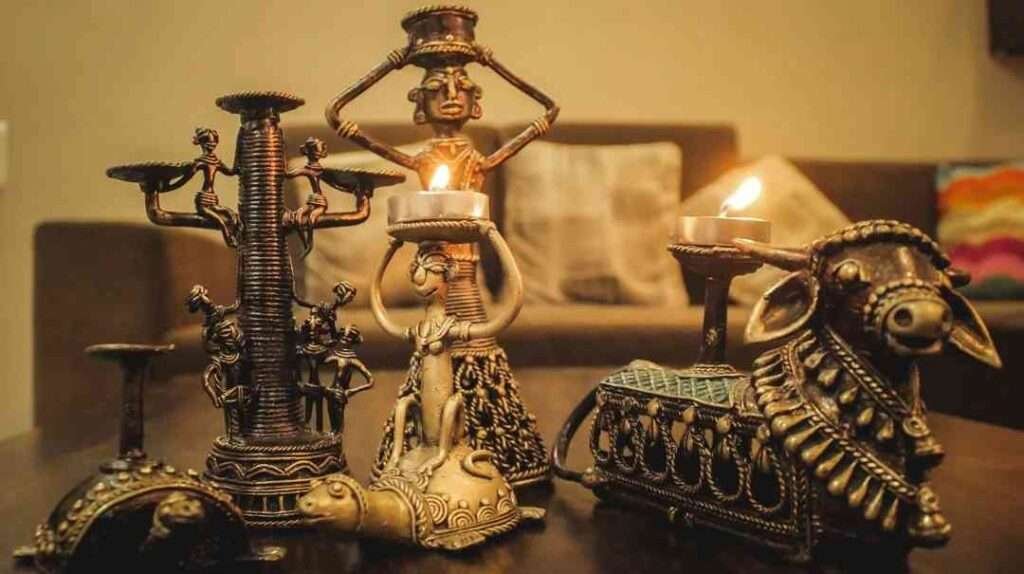
Dhokra art is perceived as a store for social legacy and is more than just a simple craft. Each Dhokra sculpture tells an ancient story that reflects the ritualistic and religious traditions of tribal communities. These stories are ancient as the art is followed through the ages. Dhokra art is a primary source of income for rural tribal people living in India. By promoting this ancient art, we open a door of financial freedom for the artists to live a sustainable life.
In contrast to mass production, Dhokra art is an environmentally conscious practice. It utilizes the lost-wax casting technique that has a minimal environmental footprint. This lines up with the worldwide pattern towards sustainability and ecological benevolence. Dokra could give a component of fascinating appeal to a cutting-edge setting. The world knows Dokra for its one-of-a-kind and complex art form.
The Origins of Dhokra Art
Historical Background
This traditional metal-crafting technique which dates back more than 4,000 years. Its origins are linked to the Indus Valley Civilization because early forms of lost-wax casting were practiced there. Archaeological evidence suggests that the Harappan civilization may have used a form of bronze casting. Also, the techniques related to it must have evolved over there. However, the form of Dhokra that we see today evolved primarily through tribal communities in eastern and central India.
One of the key factors in the survival of Dhokra art is its oral transmission. Unlike other traditional arts that may have been recorded or documented, the knowledge of the lost-wax casting technique has been passed down orally within families and communities.
Previously, Dhokra art was used to create objects practiced for performing rituals. The first evidence of this practice in India was found in the Bastar region. It is believed to have been developed around 2,000–3,000 years ago. The local tribes of Bastar still use the same ancient techniques and that is what makes this craft one of the oldest surviving forms of metalworking in the world.
The popularity of Dhokra art grew in the 19th century when the British reached rural India. During this period, the British government promoted certain traditional Indian crafts for export. Hence, the Dhokra artisans found a market for their works. This period marked the beginning of Dhokra’s entry into the global art market. The art form though faced a decline in the mid-20th century due to the rise of industrial metal casting. When Indian art collectors began appreciating the traditional value and beauty of these handcrafted objects then this art saw a revival in the 1980s.
Regions Known for Dhokra Metalwork
Dhokra metalwork is deeply rooted in the heart of India’s tribal regions. Each area contributes its unique influence to the craft. The most famous centers of Dhokra art are found in the eastern and central states of India.
One of the most significant regions is West Bengal which is home to the Dhokra Damar tribe. The art flourished in the districts of Bankura and Dariyapur. Artisans focused on jewelry and small sculptures. These areas are known for producing figures ranging from Goddess Durga to animals that are central to tribal life.
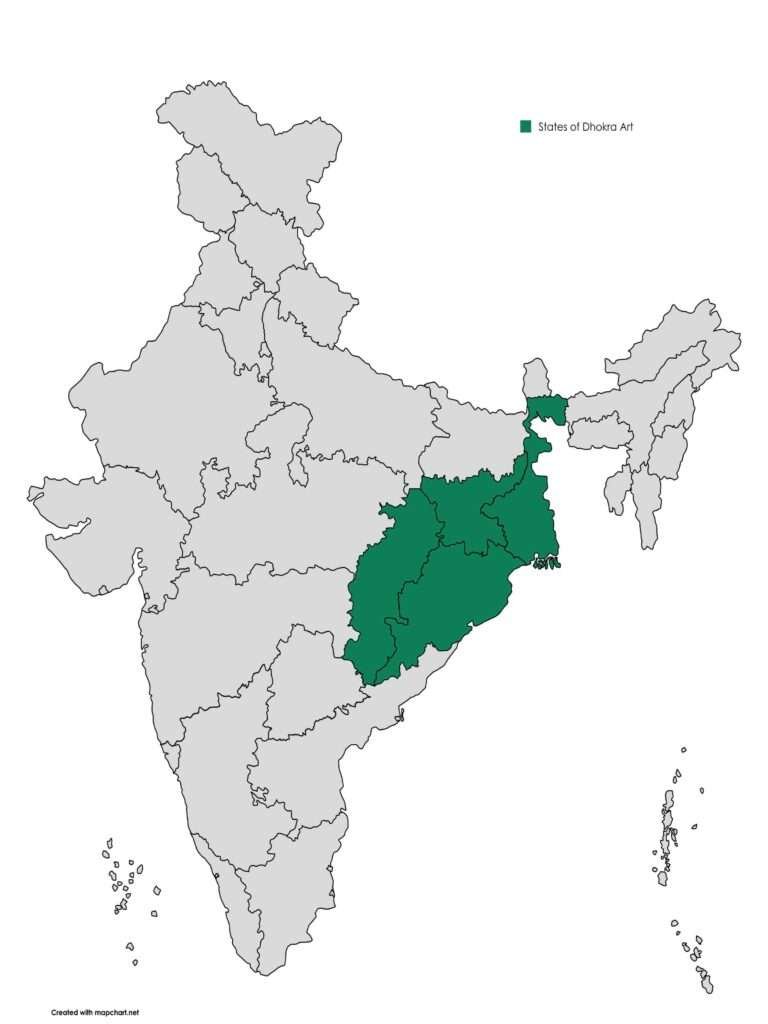
Moving southward into Chhattisgarh’s Bastar district stands out for its larger, bold sculptures. It features figures of tribal deities and mythological creatures. Bastar is known for its vibrant designs that reflect the rawness of tribal existence.
Odisha’s Dhenkanal is the place where artisans have perfected the art of creating utility items. It consisted of items such as decorative trays and lamps. Each region preserves the art form and also infuses it with local culture. It creates a diverse and colorful spectrum of Dhokra art across India.
The Influence of Tribal Communities
Tribal communities are the lifeblood of Dhokra art. It serves as both its custodians and its most passionate advocates. For centuries, these communities practiced this ancient craft in West Bengal, Odisha, Chhattisgarh, and Jharkhand.
Dhokra art also serves as a means of communication. Tribal artisans tell stories of their ancestors and their connection to the environment through motifs and symbols. These stories have been passed down orally which preserved a rich heritage that otherwise might have been lost.
Many Dhokra pieces reflect the spiritual world in which these communities live depicting deities like Lord Ganesha in detail. These representations depict deep profound meaning. It is believed to invoke protection and prosperity from nature. Animals such as elephants, horses, and tigers also feature in Dhokra art.
The Lost-Wax Casting Technique in Dhokra Art
Step-by-Step Process of Lost-Wax Casting
The art of Dhokra is made by the unique lost-wax casting technique. It is a method that traces its origins thousands of years back. Firstly, the artisan shapes a model using clay to outline the design. This model serves as the base for the piece. A mixture of wax and resin is applied to the surface of the model after the basic form is created.
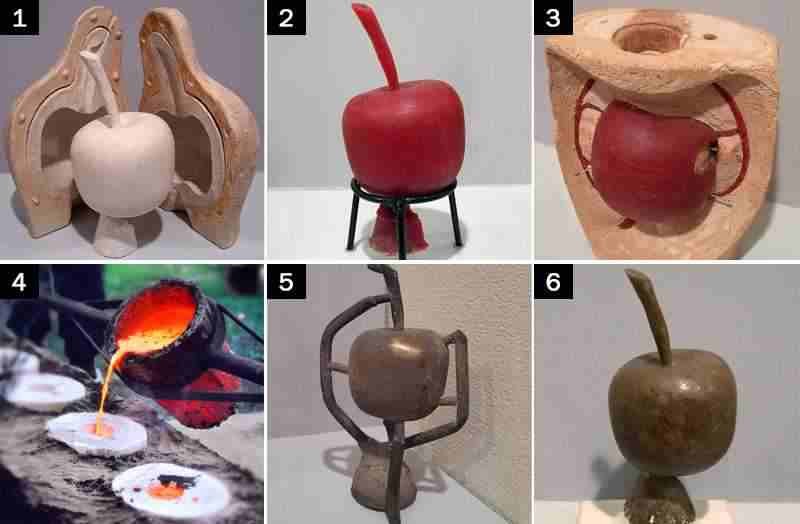
The artisan uses tools to carve complex designs once the wax layer is smooth and detailed. These designs are inspired by nature, animals, and tribal symbolism. After this, the model is coated in a thick layer of clay. Hence it forms a shell around the wax. This layer is left to dry and harden.
The next step is the most dramatic. The mold is heated to a high temperature which causes the wax to melt and drain out. It leaves a hollow cavity within the clay shell. After cooling, the molten metal usually is poured into this cavity. After the metal has solidified, the clay mold is broken away. Then the finished piece which is revealed is a unique artifact with every detail captured from the wax design. This ancient technique results in unique creations.
Materials Used in Dhokra Metalwork
The materials used in Dhokra art are found in the environment surrounding the craftsmen. The primary material beeswax is mixed with resin to create a durable layer over the clay model. Beeswax is used because of its ability to melt evenly during the casting process. It leaves a smooth and hollow mold. The outer mold is made from natural clay. It is sourced locally and molded to fit around the wax. The artisans use different types of clay depending on the region. In some regions, finer clays are used for detailing.
The most important material in the final stages of the casting process is non-ferrous metal. Generally, brass or bronze is used. These metals are chosen for their durability and ability to hold details when cooled. The use of brass and bronze gives Dhokra art its unique appearance and adds to the longevity of each piece. Tools for engraving the designs are made from stone or metal. They are used to add delicate patterns and motifs. These tools are handmade by the artisans.
Dhokra Art Across Eastern India
Dariyapur (West Bengal)
Dariyapur is a village in West Bengal. It is one of the most significant centers for Dhokra art. The craftsmen from this village are highly skilled in producing detailed pieces. They are known for jewelry and small sculptures. The local Dhokra Damar community has passed down this art from generation to generation. It maintains the authenticity of the techniques while also adding a distinct local flavor.
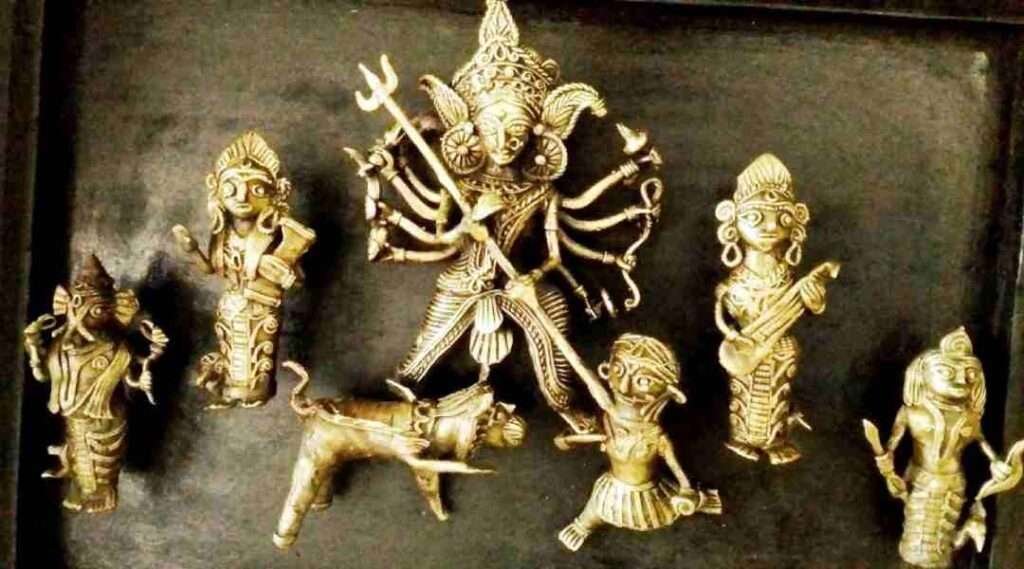
One of the most notable contributions from Dariyapur is its Dhokra jewelry. It includes earrings, necklaces, and pendants. They are characterized by geometric patterns and motifs inspired by nature. The artisans here create jewelry that embodies the aesthetic sensibilities of tribal life. They use symbols of animals, plants, and deities.
Dariyapur’s small sculptures range from deities like Lord Ganesha to miniature figures of animals. It reflects the region’s deep spiritual connection. These sculptures are crafted with extraordinary precision and are used in religious rituals. The Dhokra metalworkers of Dariyapur have managed to carve a niche for themselves in the global art world. This has made Dariyapur a crucial hub for this ancient craft.
Bastar (Chhattisgarh)
The Bastar region is situated in the heart of Chhattisgarh. It is famous for its large scale Dhokra sculptures. Artisans from this region are known for creating bold works. It depicts tribal life, nature, and mythology. The unique thing about Bastar’s Dhokra is the scale and detail of the creations. It involves figures of gods, goddesses, animals, and everyday life.
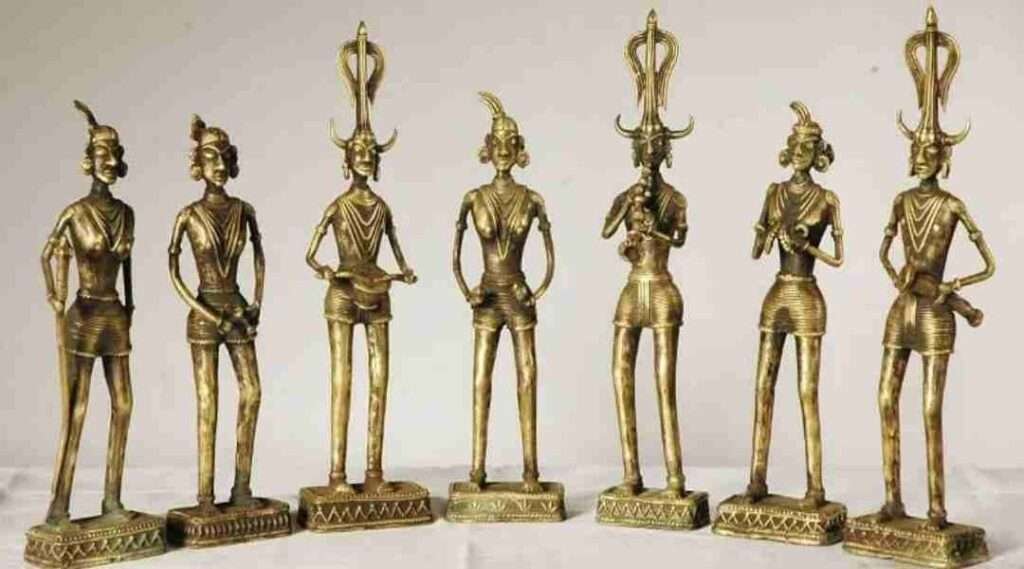
One of the most iconic symbols of Bastar’s Dhokra art is the tribal deity sculptures. These pieces often represent gods and goddesses from tribal folklore. It is designed to capture the essence of these spiritual beings. The Dhokra elephants and tigers from Bastar are among the used creations. It depicts their expressive detail and grandeur.
Bastar’s Dhokra art has maintained a connection to its roots while slowly gaining popularity outside the region. The artisans of Bastar have brought their masterpieces to the global stage through fairs and exhibitions. These large sculptures are not just symbols of tribal life but also a testament to the craftsmanship of Bastar’s artisans.
Dhenkanal (Odisha)
In the state of Odisha lies Dhenkanal. Here the Dhokra metalwork is used to make everyday and decorative items. Dhenkanal’s artisans excel at producing decorative trays, lamps, and jewelry boxes.
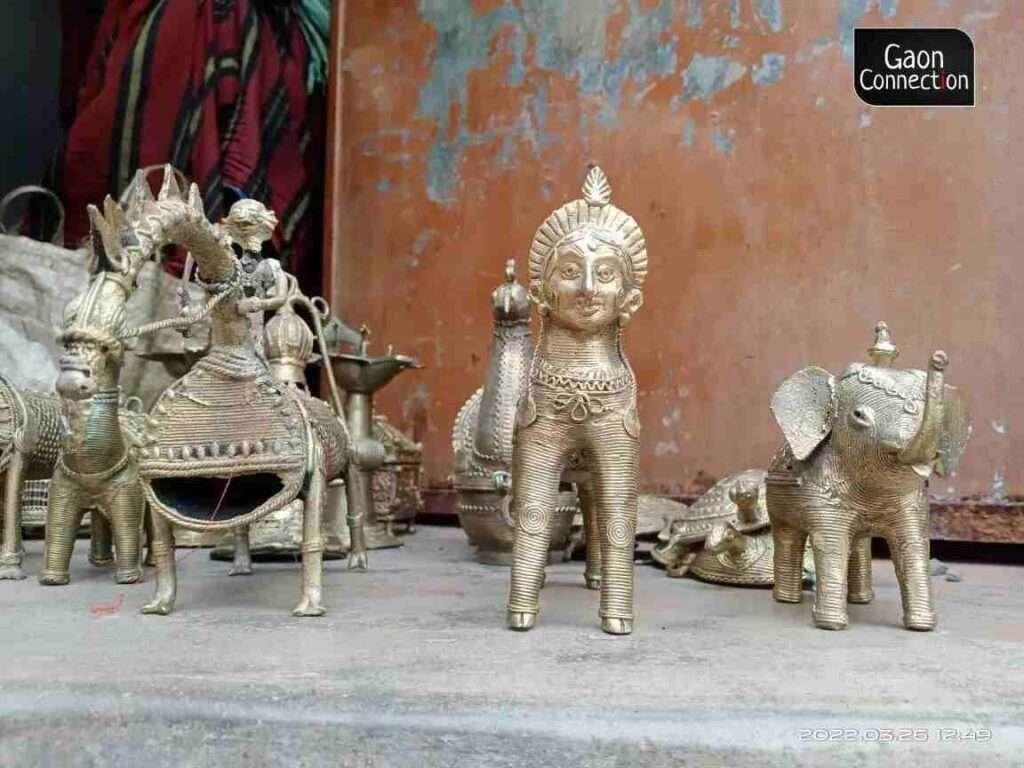
Dhenkanal’s Dhokra art is different in terms of motifs and patterns that adorn these everyday items. These designs reflect the region’s natural surroundings flora and fauna. The decorative lamps have complex carvings of peacocks and lotuses. It symbolizes beauty and grace in tribal culture. These items are functional but carry deep spiritual and cultural significance.
The artisans of Dhenkanal used brass and bronze to craft their pieces. Pouring molten metal into molds made of clay and wax. The result is a product that is both beautiful and durable. It is perfect for use in everyday rituals. It is also used for decorative purposes in homes and temples. The small scale items produced here are highly valued by collectors. Dhenkanal’s Dhokra art remains an enduring symbol of Odisha’s rich artistic heritage.
Popular Dhokra Art Creations
Sculptures: Deities, Animals, and Everyday Life
Sculptures are the most popular craft. They beautifully blend religious symbolism with tribal life. These sculptures depict Lord Ganesha, Goddess Kali, and other tribal gods. Each figure is crafted to reflect the spiritual essence of the community. These deities are not only revered but also serve as protectors of the tribe.
Animal sculptures are also common. They comprise elephants, tigers, and horses. These animals are more than mere representations of nature. They are symbols of power, freedom, and spirituality. The horses are seen as a symbol of movement and agility.
Dhokra sculptures also capture everyday tribal life. Common portraying figures are women gathering water, men working, and children playing. These scenes reflect the simplicity and harmony of tribal existence. It makes the sculptures not only artistic expressions but also historical records of the tribe’s way of life. Dhokra art allows a glimpse into the past through these complex creations.
Jewelry: Earrings, Necklaces, and Pendants
Dhokra jewelry is another popular form of creation. It is renowned for its unique charm. Earrings, necklaces, and pendants made by tribal artisans are bold and have detailings. The designs feature geometric patterns, spirals, and symbols drawn from nature, such as leaves, flowers, and animals.
One of the standout features of Dhokra jewelry is the heavy use of symbolism. The earrings are designed to resemble the shape of peacock feathers or lotus flowers, symbols of beauty and purity in tribal culture. Necklaces and pendants may carry images of deities or animals. It represents spiritual beliefs or offering protection.
Utility Items: Lamps, Boxes, and Decorative Trays
Dhokra is associated with sculpture and jewelry. However, utility items like lamps, boxes, and decorative trays are also valued for their beauty and functionality. These items are designed to be practical while also reflecting the artistic traditions.
Lamps are among the most popular creations. It features patterns of animals, birds, and foliage. These lamps are not just light sources but symbols of life, light, and prosperity. The decorative trays made by Dhokra artisans are beautifully engraved with tribal motifs.
It makes them perfect for use in ceremonies or as ornamental objects in homes. Boxes made in Dhokra art serve both a functional and ceremonial purpose. They may hold jewelry, valuables, or ritual items. They are decorated with symbolic motifs that carry blessings for the user.
Conclusion: Preserving Dhokra Art for Future Generations
Why Dhokra Art Matters Today
This art holds immense cultural value in today’s society. This ancient craft not only preserves the age-old traditions of India’s tribal communities but also offers a sustainable alternative to industrial items.
Globalization brings more attention to indigenous crafts. This art form has gained international recognition. The resilience of this craft passed down through generations, is a testament to the skill and perseverance. For these communities, Dhokra is not just a livelihood—it is a vital connection to their identity, spirituality, and way of life.
For further reading on and its significance, you can visit these useful resources:
Check out our Blog Page on Traditional Indian art.

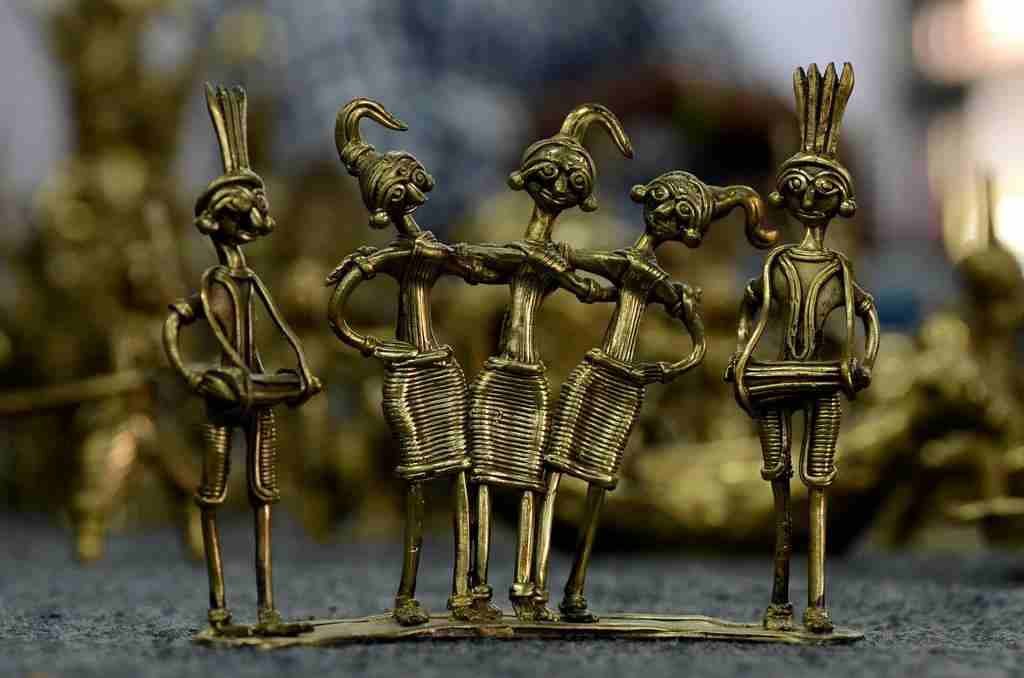
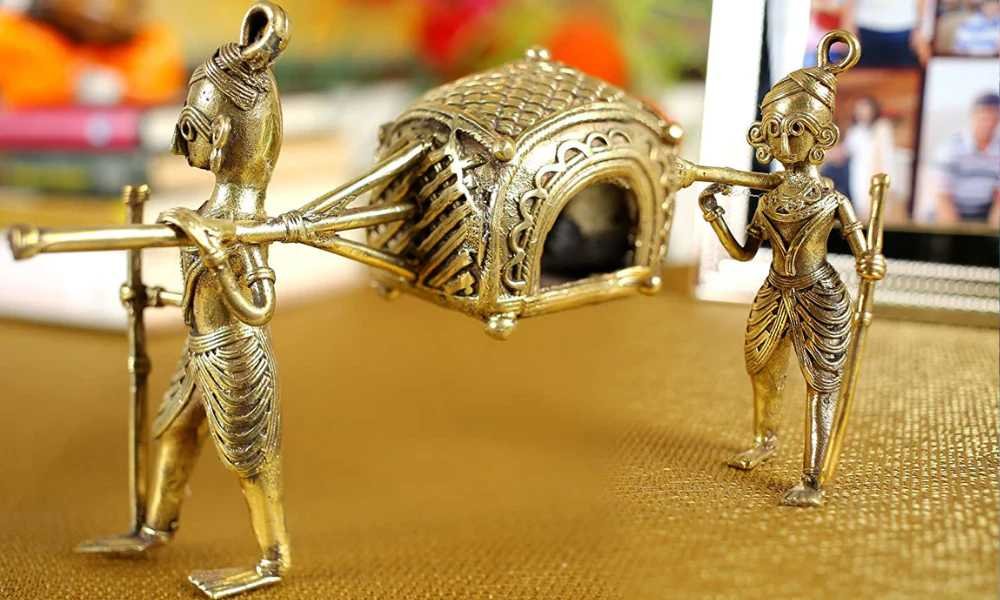
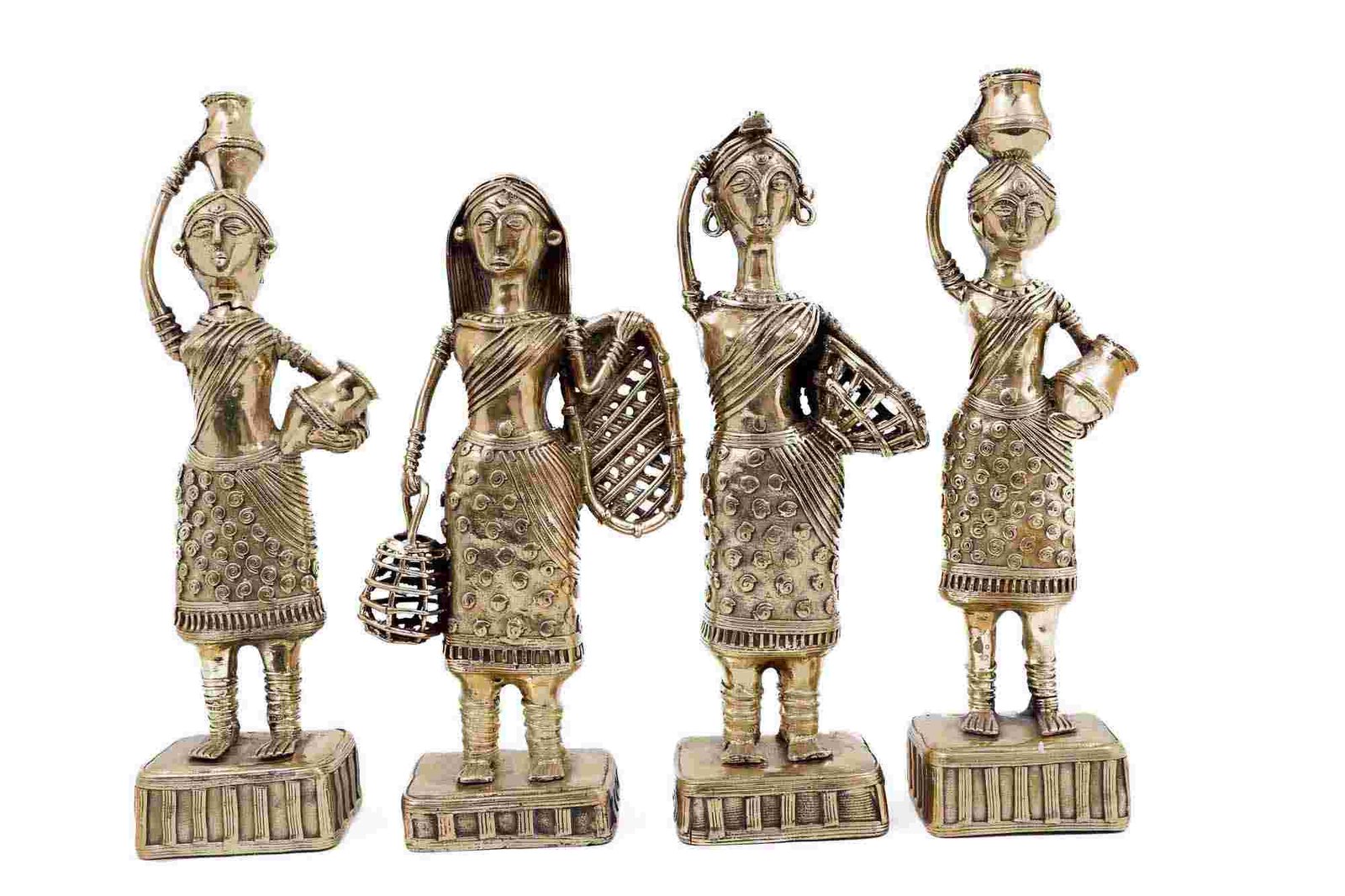
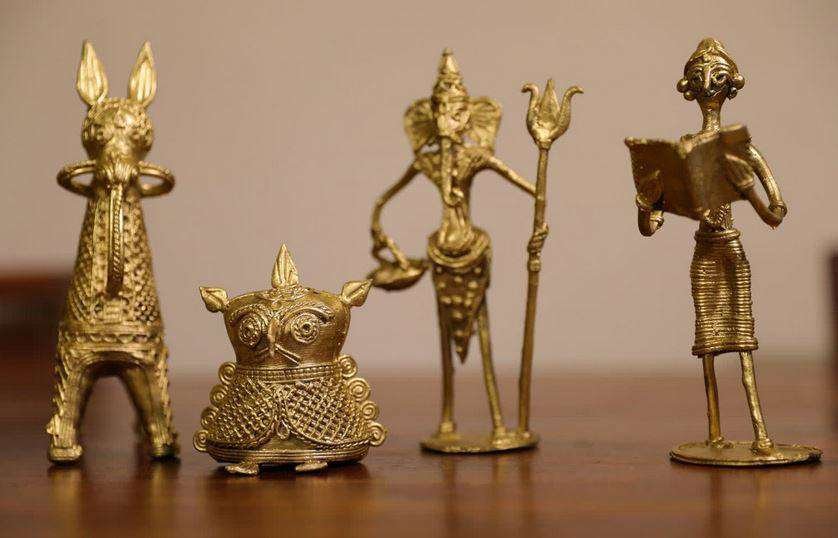
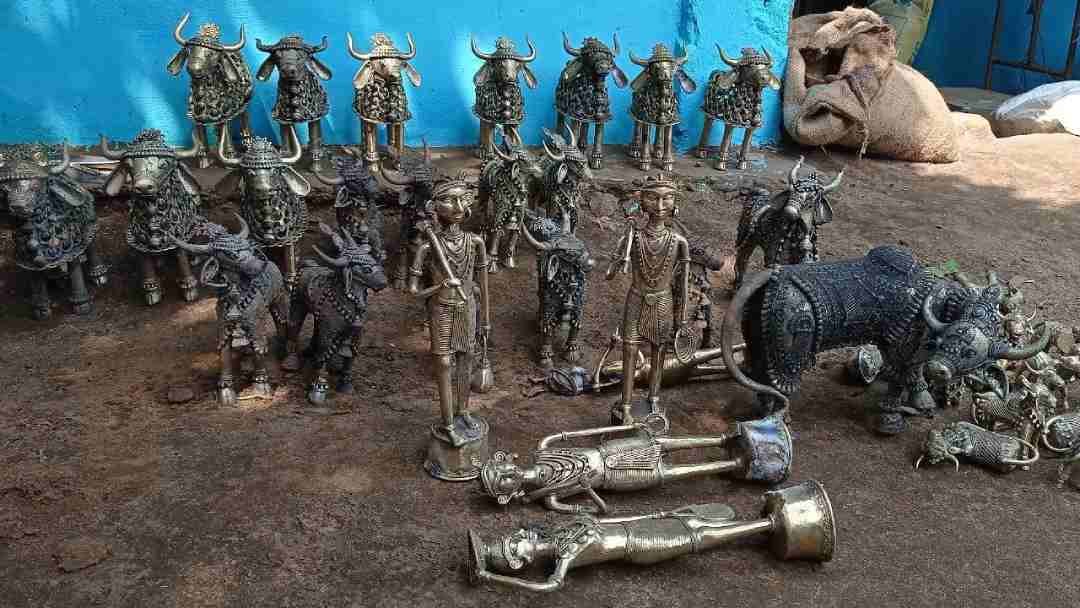
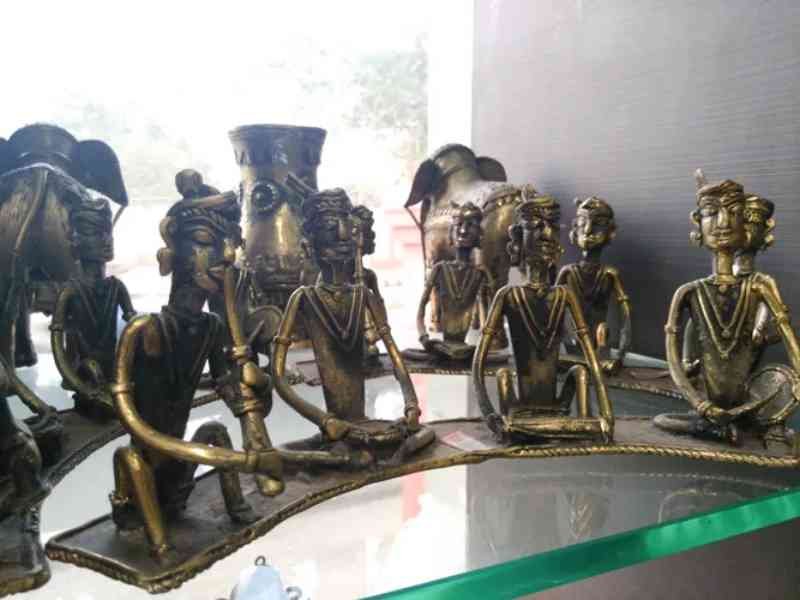
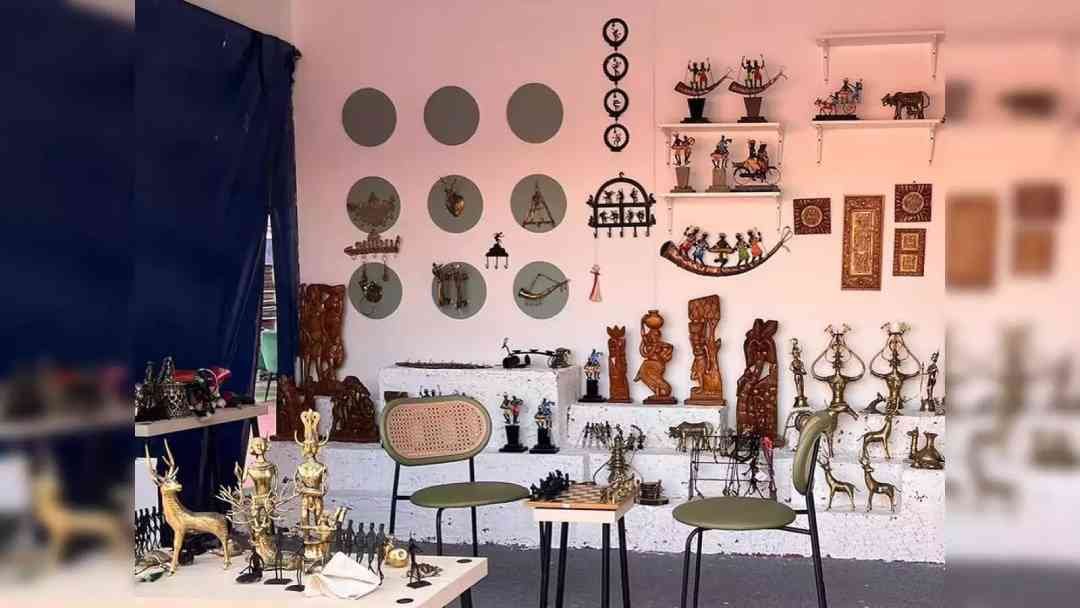
Leave a Reply